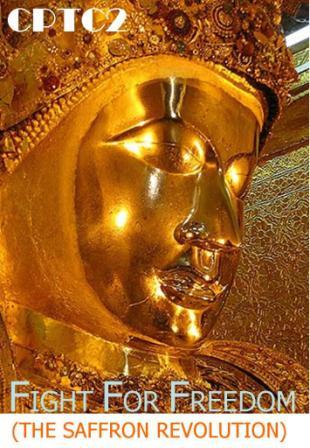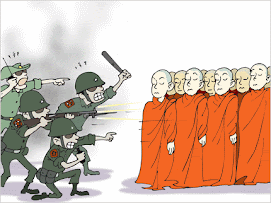
UN envoy Ibrahim Gambari posing for a picture with detained democracy
leader Aung San Suu Kyi during discussions in Rangoon. [Photo: AFP/UNIC-HO]
Suu Kyi Wants “Proper Dialogue”
By Lalit K Jha/ United Nations October 8, 2007
The UN Envoy to Burma, Ibrahim Gambari, last week said that the popular Burmese pro-democracy leader, Aung San Suu Kyi, who has been under house arrest for more than 11 of the last 18 years, is anxious to engage in dialogue with the ruling military junta.
UN envoy Ibrahim Gambari posing for a picture with detained democracy leader Aung San Suu Kyi during discussions in Rangoon. [Photo: AFP/UNIC-HO]
Gambari, who met the iconic Suu Kyi twice during his four-day stay in Burma last week, told reporters at the UN headquarters that from his own observations, “She (Aung San Suu Kyi) appears to want proper dialogue.”
He was responding to a question on whether Suu Kyi has shown any flexibility on the four conditions set by the Burmese general for any dialogue with her.
In response to a question, Gambari said, “The Secretary General has characterized it (dialogue) as being without preconditions, because that would be the best way to move forward. You just start talking. Because there is so much distrust between her and the senior general, the bridge has to be built; and the best way in our view is to start.
“I think there is an opening for dialogue. From this, the expectation is not a dialogue for the sake of it, not an open-ended dialogue, but dialogue that is targeted at achieving national reconciliation in an all-inclusive manner; a constitution that reflects the will of the majority of the people, and also a government that is responsive to the needs of their own people.”
When asked about the health of Suu Kyi, Gambari said, “… You saw her picture; some people say she looked frail, but actually I thought she looked better than last November, when I saw her last. She herself said she is in fairly good health, under the circumstances of her continued detention.”
Gambari added that the important thing is to have her restrictions eased.
“In terms of her own position on sanctions, I think we have to find ways to get her own point of view on record, rather than me interpreting her position,” Gambari said.
Gambari said the UN is waiting for a concrete response from the Burmese government on the issues raised by him. These include: release of political prisoners; humanitarian access to those in need; cessation of hostilities against ethnic minorities; health and educational issues; and co-operation with the ILO.
“Then we have added some new ideas; for example, how to deal with the underlying process of discontent of an economic and political nature, and also possible ideas about constitution review. Now we are just waiting for the response. We will judge by what they actually do,” Gambari said in response to a question.
After his third briefing before the Security Council in ten days, Gambari said five points of consensus have emerged.
“One is that unity among Council members is the key to really getting Myanmar and the authorities to move along the lines that we all want, which is peaceful, democratic Myanmar, with full respect for human rights,” he said.
“Secondly, there is strong support among all Council members for the role of the good offices of the Secretary General.
“Third, there is a consensus… that the status quo ante is unacceptable and unsustainable and is probably unrealistic. We cannot go back to the situation before the recent crisis. The underlining factors—socio-economic and political—must be addressed,” he said.
Fourth is the critical role of Asean, the neighboring countries and regional powers.
“The fifth point that emerged by consensus in the discussions is that a return visit to Myanmar and to the region would be useful in order to keep the momentum, which we must not allow to slip,” Gambari said.
The Drama behind the Decision to Use Deadly Force
By The Irrawaddy October 8, 2007
The decision to use deadly force—to shoot Buddhist monks and activists in Rangoon—was made by junta leader Snr-Gen Than Shwe, but there were moments when the army—senior and junior officers—appear to have disagreed on how to handle the protests.
A source in Rangoon, who has since left the city, told The Irrawaddy that there was a time when the possibility of a coup seemed real, there were some top commanders who did not want to use deadly force and there was real tension within the junta.
The drama, which began prior to the bloodiest days of the protests, involved Than Shwe and his core of hardliners versus Vice Snr-Gen Maung Aye, the military commander in chief, who, in a strategy meeting in Naypyidaw prior to the bloodshed, argued against using the military to put down the street demonstrations.
Instead, Maung Aye proposed using police and paramilitary forces, said a source close to Maung Aye, the No. 2 man in the junta. Than Shwe, who presided at the meeting, decided to use the army.
Also at the meeting were Joint Chief of Staff Gen Thura Shwe Mann; Quartermaster General Lt-Gen Thiha Thura Tin Aung Myint Oo; Military Affairs Security head Lt-Gen Ye Myint; and Secretary one Lt-Gen Thein Sein.
Perhaps reflecting Than Shwe's distrust of placing too much authority in the hands of any one commander, he authorized the suppression to be carried out by various commanders, including Maung Aye, Thura Shwe Mann, Ye Myint, the Home Affairs Minister, Maung Oo; the Head of Bureau of Special Operations-5, Lt-Gen Myint Swe; and the Minister of Industry, Aung Thaung.
When the monk-led protests in Rangoon gained momentum, Maung Aye went to the former capital on September 27 to meet with battalion commanders. Seven battalions were deployed in Rangoon to control the street demonstrations, each with about 500 soldiers.
Some army officers reportedly were in hopes of avoiding the use of deadly force against monks and civilians.
Indeed, sources close to the army said Maung Aye issued an order not to shoot monks and activists.
However, the junta's No. 3 man, Thura Shwe Mann, backed by Than Shwe, bypassed Maung Aye's order, and issued a shoot-to-kill order.
Perhaps illustrating the confusion in the ranks, Maj-Gen Ko Ko, the regional commander of the Southern Command, reportedly received the order to use deadly force from Thura Shwe Mann. Ko Ko reportedly told Shwe Mann he would like the order to come from Maung Aye.
Tensions in the ranks increased during the peak of the crisis, sources said, and some regional commanders sent clear signals to Maung Aye that they were ready to obey any order he gave them, but the army chief did not make any move against Than Shwe.
Some battalion commanders and regional commanders reportedly wanted Maung Aye to meet Aung San Suu Kyi during the crisis, especially after she appeared in front of her residence to speak with protesting monks. Suu Kyi and Maung Aye reportedly got along well during a dinner with Than Shwe and then intelligence chief Khin Nyunt several years ago.
The sources said Maung Aye ordered additional soldiers stationed in front of Suu Kyi's house to protect her in case of plots against her by hardliners.
After UN Special Envoy Ibrahim Gambari’s visit to Naypyidaw, it was reportedly Maung Aye who encouraged Than Shwe to offer to meet with Suu Kyi. Faced with growing pressure from inside and outside Burma, Than Shwe made an offer to meet but with conditions that almost guaranteed Suu Kyi would not accept, such as an end to economic sanctions, no public confrontations and other meausres. Surprisingly, none of the conditions have been rejected out of hand and some observers are leaving the door open to a future meeting between the two.
While speculation increased—perhaps wishful thinking—that the nationwide civil unrest might prompt more forward thinking elements in the military to stage a coup, it was simply not to be.
Maung Aye's critics say he's proved himself to be too soft to challenge Than Shwe. Pragmatic observers, say, in fact, Maung Aye has his own particular weaknesses, and he's clearly been out maneuvered by Than Shwe. He has few close colleagues, is relatively isolated in Naypyidaw, and doesn’t have a well established power base. In the 2006 army reshuffle, Than Shwe put even more of his men in key positions in the armed forces.
When Khin Nyunt was in power as army intelligence chief, rumors swirled around Maung Aye and Khin Nyunt, saying they had agreed to remove Than Shwe if an opportunity arose.
But Than Shwe took action against Khin Nyunt first, placing him under house arrest in October 2004.
But for some, hope springs eternal. The army commander in chief is still believed to have enough backing among elements of the army to make a challenge, if he ever decided to stage a coup against Than Shwe.
“He has all the cards, but he didn't want to play,” complained the source.
The question now is—if all the reports are true—for how much longer will Maung Aye have a seat at the table?
Monday, October 8, 2007
Suu Kyi Wants “Proper Dialogue”
Posted by
CINDY
at
3:59 PM
![]()
Subscribe to:
Post Comments (Atom)





























No comments:
Post a Comment